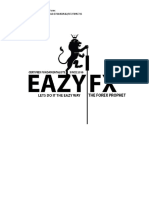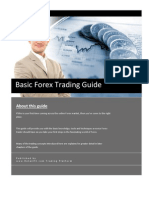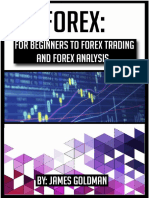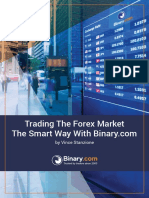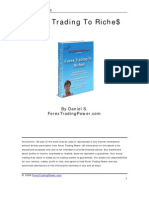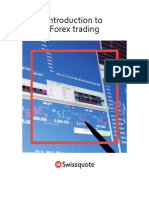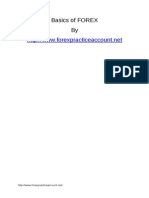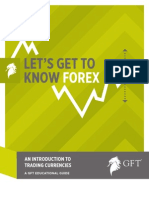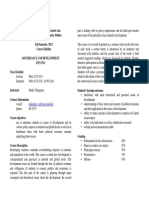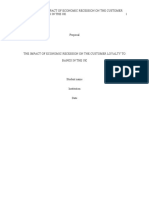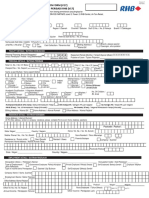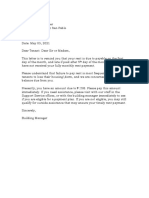Free!
Improve Your Current Financial
Situation Through Trading Foreign
Currencies.
An Introduction.
By
Henry W.
1
� Congratulations! You have resell rights to this publication. You
can freely distribute it in any way you wish as long as it remains
unaltered. You may also sell it at any price you wish, by any media
and may pass on resell rights to anyone you wish.
Disclaimer
The author assumes no responsibility for the use or misuse of this
product, or for any injury, damage and/or financial loss sustained
to persons or property as a direct or indirect result of using this
report. We cannot guarantee your future results and or/success, as
there are some unknown risks in business and on the Internet that
we cannot foresee.
The use of our information should be based on your own due
diligence, and you agree that the author is not liable for any success
or failure of your business that is directly or indirectly related to the
use of this information.
2
�Content
I. Introduction to a new possibility -- Page 4
II. What is the Forex market? -- Page 5
III. Trading Hours -- Page 6
IV. Differences of FX to other markets -- Page 8
V. How Currency Trading Works -- Page 10
VI. What Is Long or Short? -- Page 13
VII. What price to buy and sell? -- Page 14
VIII. Calculating your P&L -- Page 16
IX. What is a margin? -- Page 20
X. Suitable trading styles for you -- Page 22
XI. What kind of trader are you? -- Page 24
Technical trader -- Page 24
Getting to know your charts -- Page 25
What is a trend? -- Page 30
Support and Resistance -- Page 32
Trend lines -- Page 36
Channel line -- Page 38
Reversals -- Page 39
Moving averages -- Page 42
Fundamental approach -- Page 46
Technical or Fundamental? -- Page 47
XII. Knowing the psychological aspects -- Page 48
XIII. Getting started -- Page 50
Know your Orders -- Page 52
XIV. Reasons to trade Forex -- Page 54
XV. Benefits of Forex trading -- Page 56
3
� I. Introduction to a new possibility
Before jumping into the introduction of the Foreign Exchange market, let
me point out why I decided to write this book. The main reason is that I
have been working so hard for long hours and for a pay that is not worth
mentioning. I found that with that job that I had, I had neglected my loved
ones, and even worked myself sick! I found myself not enjoying my work
days, as I dragged myself out of bed to go to work and hoping the
nightmare would end. Health problems started coming, and we all know
that the costs just to visit a doctor and getting your medicines can be costly.
I started questioning my worth. I talked to my superiors and did get my
increments, but I knew I was still underpaid. I knew I can get more. I knew
that I am worth more than what they gave me. I can make more in less
time than working from others for long hours and getting the same
paycheck. In my line of work, I was already exposed to the foreign
exchange market but did not utilize it until I was sick and tired of my work.
Severely overworked and underpaid, with theories in hand, I opened my
currency trading account, and experimented with trading techniques and
styles, and learning through experiences and external sources on how to
trade better, while working full time.
There were losses incurred at first, but the frequency of losses made
reduced, and the gains started coming. I know I can make more. I know I
am worth more, and I feel better day by day.
Trading this flexible market does help in bringing in more cash, and I can
even trade this market during working hours or after that when I am at
home. And, I know that I can trade this market full time if I wanted to.
Why did I write this book? Maybe I want to let more people, who are like
me, know about another option of making money and not to be stuck in a
situation that they are not happy at day by day. So, let me start with the
introduction of this flexible and rewarding market.
4
� II. What is the Forex market?
The foreign exchange market, or usually called the forex or FX market, is
the largest and most traded financial market in the world. Foreign
exchange is the simultaneous buying of one currency and selling another,
and will be present when a Japanese father is looking to buy some Kiwi
dollar for his children studying in New Zealand, a Malaysian company
looking to invest in China and having to hedge the Malaysian Ringgit to the
Chinese Yuan, a U.S. company buying parts from Canada having to pay in
Canadian dollars, to an Australian traveler planning to travel to Bangkok
having to buy some Thai Baht to use for his or her stay there.
There will be more examples to the above listed, but the 2 main reasons to
buy and sell currencies are that about 5% of daily trades come from
companies and governments that buy or sell products, or services,
investments, and other interests in a foreign country or must convert
profits made from foreign countries in foreign currencies to be converted
into their own domestic currency. The other remaining daily trades come
from speculation.
A most commonly traded market, and most liquid, will be the best market
for any traders, as it will be faster and easier to buy and sell the stock or
commodity. Also, liquidity is very important as it determines how quickly
prices move between trades. Thus it will be easier to buy and sell at your
target prices in a liquid market.
The above holds true for the foreign exchange market, and there are even
more trading opportunities with the most commonly traded and most
liquid currencies, which are the major currencies. It has been estimated
that more than 85% of all daily transactions are taking place in the major
currencies like US Dollar, Japanese Yen, Euro, British Pound, Swiss Franc,
Canadian Dollar, and Australian Dollar.
5
�III. Trading hours
The currency market opens for 24 hours for six days a week, normally from
Sunday 5:00 PM ET to Friday 5:00 PM ET, and trading normally begins in
Wellington, New Zealand and moves around the international financial
centers to like Sydney, Tokyo, London, and New York, enabling traders to
react to news and events as they happen.
Currency trading does not stop for holidays and will be open even if the
other financial markets, like stocks or futures exchanges, are closed. The
only holiday for the currency market is New Year’s Day, where the rest of
the world stops to celebrate the arrival of a new year.
It is also the place where a hundred million dollar trade can take place in a
matter of seconds and a click of a button. That will be the domain of the
banks and the hedge funds. But, we do not have to worry about that, as
with a daily average turnover of US$2 trillion, the hundred million dollar
trade looks small in comparison. It has been stated that to understand how
big the average daily turnover is, it is about 10 to 15 times the size of daily
trading volume on all the world’s stock markets combined.
Currency trading can be divided into 3 sessions. As the market starts in
Wellington, the currency markets begin in the Asia-Pacific session. The
principal financial trading centers are Wellington, Sydney, Tokyo, Hong
Kong, and Singapore. That means news and data reports from New
Zealand, Australia, and Japan will have an impact on the market during this
session.
As we move across the globe, the European financial centers begin to open,
giving us the European/London session. News and data reports from the
Eurozone (countries like Germany), Switzerland, and London will have an
impact on the market during this session. As a result, European currencies
like the British Pound, the Euro, and the Swiss Franc will likely be the
biggest movers here.
Continuing our move across the globe, we will come to the North American
session, where the key U.S. economic data will make an impact on the U.S.
6
�Dollar. Reports are usually released at around 8.30 to 10.00 AM ET and the
Canadian data coming out at around 7.00 to 9.00 AM ET.
With the overlapping of the European session with the Asian trading hours
and the North American hours, this is the session where you can find the
most market interest and liquidity.
Thus, after knowing the trading hours, you can plan your trading time.
7
� IV. Differences of FX to other markets
Due to the large volume of participants in the market, the risk of insider
information is greatly reduced. The market usually moves in anticipation
to news that is released in the market. News like whether the Bank of
Japan will increase lending rate etc. Thus, the news will be made known to
everyone.
Also, the volatility of the major currencies rarely exceeds 1% per day, in
contrast to the volatility of stocks, which may fluctuate by up to 10% over
one trading session.
Trading is not centralized on an exchange and can be conducted between
two counterparts over the telephone, or via an electronic network, as the
currency market is considered an Over-The-Counter (OTC) or interdealer
market. Thus you do not go to the New York Stock Exchange to place your
currency orders, but you will have to go through a brokerage firm to place
your orders. Placing your orders can mainly be done through the trading
platform that your broker will provide to you, or through telephone calls to
your broker.
Of course, the biggest advantage that you will get from trading the Forex
market is that this market is open 24 hours for 6 days in a week instead of
the standard a few hours of trading hours per day for some other financial
and commodity futures and equities markets. With the continuous trading
hours, you can easily enter into a trade at your preferred time, and correct
your positions at any point in time. So, you can trade when you are in the
office before your lunch, during your teatime if you have that privilege,
before your boring meetings, before dinner, after dinner, during supper,
while watching your late night movies… You decide.
Also, with the large number of players in the market, with the narrow
spreads provided, you can easily meet your target profit level faster.
Remember, the best difference that the Forex market can provide you is to
trade on your schedule, day or night, instead of you having to follow a
certain trading hour for the day. You are the master of your trading time.
This is useful for people who are burdened with a 9 to 5 work, or other
8
�professions with long working hours. This opens the game to many
individuals who might not have the time available to trade normally. You
can also be traveling in another country and still be trading on your
currency account.
9
� V. How Currency Trading Works.
As you know from above, currency trading is the simultaneous buying of
one currency and selling another. In a stock market, when a participant
buys a share, he or she will own that share. When the participant wants to
exit from the position, he or she will have to sell that share.
In currency trading, the purchase of a currency will have to involve the
simultaneous sale of another currency. To put it simply, remember the
example of the Australian traveler? For the traveler to be able to pay for
food and expenses while he or she is staying in Bangkok, the traveler will
have to buy some Thai Baht, and sell the Australian dollar, the domestic
currency. Thus, when the traveler is at the money changer in the airport in
Australia, he or she will have to sell the Australian dollar carried in the
pocket, and buy the Thai Baht.
The logic of buying and selling simultaneously is easy if you see that you
are looking to buy or sell the desired currency against another currency.
So if a trader is looking for the U.S. Dollar to strengthen, the trader will
have to think that the dollar will have to go stronger against another
currency. Thus currency trading comes in pairs, and traded or exchanged
against one another.
For the major currencies that we have discussed above, the following will
be the codes for the most frequently traded currency pairs:
Major U.S. Dollar Currency Pair:
- EUR/USD, or Euro-Dollar
- USD/JPY, or Dollar-Yen
- GBP/USD, or Sterling-Dollar
- USD/CHF, or Dollar-Swiss
- USD/CAD, or Dollar-Canadian
- AUD/USD, or Aussie-Dollar
10
� Thank You for previewing this eBook
You can read the full version of this eBook in different formats:
HTML (Free /Available to everyone)
PDF / TXT (Available to V.I.P. members. Free Standard members can
access up to 5 PDF/TXT eBooks per month each month)
Epub & Mobipocket (Exclusive to V.I.P. members)
To download this full book, simply select the format you desire below


